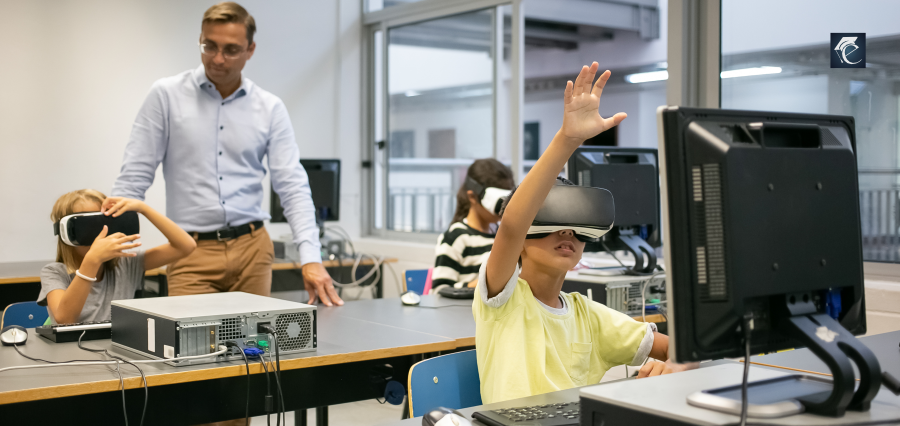- December 17, 2025

The education landscape has undergone a dramatic transformation in
recent years. With the rise of digital technology and remote learning,
classrooms have expanded beyond physical walls into virtual environments that
are dynamic, interactive, and learner-centric. From artificial intelligence to
immersive virtual learning, a wave of innovative tools and platforms is driving
the evolution of digital classrooms. This article explores the top EdTech tools
and platforms that are set to redefine learning in 2025.
Learning Management Systems (LMS)
At the heart of the digital classroom lies the Learning Management
System. These platforms organize and deliver course materials, track student
progress, and facilitate communication between educators and learners. By 2025,
LMS platforms will be more advanced, offering features that support
personalized learning, real-time feedback, and seamless integration with
third-party applications.
Platforms such as Moodle, Canvas, and Google Classroom continue to
dominate, while newer entrants like ClassDojo and Schoology are gaining
popularity for their user-friendly interfaces and analytics capabilities.
Educators can assign tasks, conduct assessments, and monitor performance with
precision, enabling a more informed and efficient teaching approach.
Artificial Intelligence and Adaptive Learning
Artificial Intelligence is revolutionizing the way students learn by
making education more personalized and responsive. Adaptive learning platforms
use AI to analyze a student’s strengths, weaknesses, and learning pace. Based
on this data, they tailor content and learning paths to suit individual needs.
Platforms like Squirrel AI and Century Tech are leading this space by
offering intelligent tutoring systems that guide students through customized
learning journeys. AI also supports teachers by automating grading, providing
predictive analytics, and offering insights that help in early intervention for
struggling students. This blend of human expertise and machine intelligence is
set to become a cornerstone of education in 2025.
Gamification and Game-Based Learning
Gamification is not just about making learning fun; it is about
improving engagement and retention. By incorporating game-like elements such as
points, leaderboards, and rewards into the learning process, EdTech tools can
boost motivation and encourage healthy competition.
Platforms like Kahoot, Quizizz, and Classcraft are widely used to
introduce quizzes, challenges, and interactive games into lessons. In addition
to making the learning experience enjoyable, these platforms provide teachers
with data on student performance and participation. As digital-native students
continue to dominate classrooms, gamified learning will remain a powerful
strategy.
Virtual Reality and Augmented Reality
Virtual Reality and Augmented Reality are creating immersive learning
experiences that were once unimaginable. These technologies allow students to
explore historical landmarks, conduct scientific experiments, and interact with
complex 3D models from the comfort of their homes or classrooms.
Tools such as Google Expeditions, CoSpaces Edu, and zSpace offer a range
of educational simulations that bring abstract concepts to life. In science classes,
for instance, students can manipulate molecules or dissect virtual organisms.
In geography, they can explore global ecosystems in 360 degrees. This hands-on,
experiential learning deepens understanding and makes education more memorable.
Video-Based Learning Platforms
Video-based learning has gained significant traction, especially during
the rise of remote education. Platforms like Khan Academy, TED-Ed, and YouTube
Education provide high-quality instructional videos that cover a wide range of
subjects and grade levels.
These resources support flipped classroom models, where students learn
concepts at home through videos and apply them in class through discussions and
activities. With the integration of interactive features such as quizzes,
annotations, and subtitles, video platforms are becoming more engaging and
accessible to diverse learners.
Collaboration and Communication Tools
In digital classrooms, communication is key to maintaining a sense of
community and engagement. Collaboration tools help students and teachers stay
connected, share ideas, and work together on projects.
Microsoft Teams, Zoom, and Google Meet are widely used for live virtual
classes and group discussions. Meanwhile, tools like Padlet and Jamboard enable
real-time brainstorming and content sharing. These platforms not only support
academic learning but also foster critical soft skills such as teamwork,
communication, and digital literacy.
Assessment and Analytics Tools
Assessment is an integral part of the learning process, and EdTech
platforms are making it more efficient and meaningful. Tools like Formative,
Socrative, and Edulastic provide a range of assessment options including
quizzes, polls, and interactive exercises. These tools offer instant feedback
and analytics, allowing teachers to adjust instruction based on student
understanding.
More advanced platforms also use learning analytics to track long-term
progress, identify trends, and recommend interventions. With data-driven
insights, educators can make informed decisions that improve learning outcomes.
Coding and STEM Platforms
As the demand for skills in science, technology, engineering, and
mathematics continues to grow, EdTech platforms are stepping up to prepare
students for the future. Coding platforms such as Scratch, Tynker, and Code.org
teach programming through interactive lessons and creative challenges.
STEM learning platforms like Mystery Science, Brilliant, and Labster
offer hands-on activities, simulations, and real-world problem solving. These
platforms make complex topics approachable and encourage curiosity and critical
thinking among learners.
Conclusion
As schools, teachers, and students embrace these innovations, it is
crucial to focus on accessibility, data privacy, and teacher training to ensure
that EdTech serves as an equalizer rather than a divider. With the right tools
in place, the digital classroom of 2025 promises to be more engaging,
inclusive, and effective than ever before.
About the Author
Mia Jones
Mia Jones is a Managing Editor at Education Excellence Magazine.